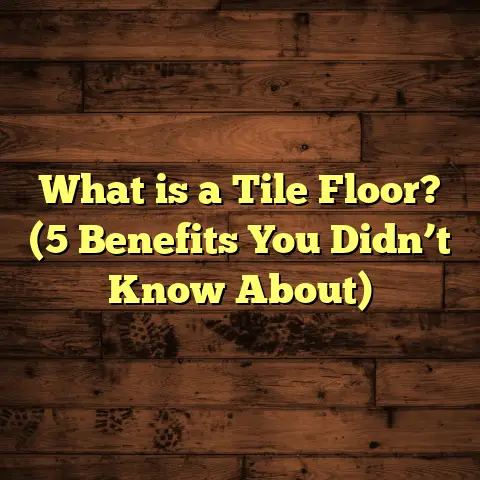What is Laminate Wooden Flooring? (5 Reasons to Choose It!)
Have you ever wondered why laminate wooden flooring has become such a buzzword among homeowners and renovators? I remember the first time I laid down laminate flooring in a client’s home, I was genuinely surprised by how versatile and practical it turned out to be. It got me thinking—what exactly makes this type of flooring so popular? Let me share what I’ve learned after years of working hands-on with laminate floors and why I often recommend it over other options.
What is Laminate Wooden Flooring?
Laminate wooden flooring is a synthetic flooring product designed to mimic the look of real hardwood. It consists of multiple layers fused together through a lamination process. Typically, these layers include a durable wear layer on top, a photographic applique layer that gives it the wood-like appearance, a core layer made of high-density fiberboard (HDF), and a backing layer for moisture resistance and stability.
Unlike solid hardwood, laminate doesn’t actually contain real wood on the surface; instead, it uses a high-resolution image layer that looks amazingly close to natural wood grains. This means you can get the aesthetic appeal of hardwood without the higher cost or maintenance hassles.
Why did I start using laminate flooring so much?
Early on, I found that many customers wanted the warmth and charm of wood floors but were turned off by hardwood’s expense and upkeep. Laminate offered a practical middle ground—good looks with less worry.
I remember one job in particular. The client loved the look of oak floors but didn’t want to spend several thousand dollars. We went with a laminate oak finish, and the result was stunning. She couldn’t believe it until she touched it and saw how durable it was.
5 Reasons I Choose Laminate Wooden Flooring
1. Affordability Without Sacrificing Style
One of the biggest draws for me—and my clients—is how budget-friendly laminate flooring is. Hardwood floors can cost anywhere from $8 to $15 per square foot installed, depending on the wood species and finish. Laminate, on the other hand, usually costs between $2 to $5 per square foot for materials alone. Installation tends to be straightforward, which keeps labor costs down as well.
For example, when I renovated my own living room last year, switching to laminate saved me around 50% compared to hardwood quotes I had received. The floor still looks stunning, and I didn’t have to empty my savings account.
If you’re curious about the exact numbers, according to a 2023 report by HomeAdvisor, the average cost for laminate flooring installation runs between $1,500 and $4,500 depending on size and material quality. Compare this to hardwood’s average $4,000 to $10,000 price tag for similar space, and you get why so many people lean toward laminate.
2. Easy Installation That Saves Time
If you’ve ever watched a professional install hardwood flooring, you know it can be a lengthy process involving nails, adhesives, and careful alignment. Laminate floors typically use a “click-lock” system where planks snap together without glue or nails. This floating floor method means faster installation and less mess.
I’ve installed laminate floors in several homes within just a couple of days, even in rooms over 500 square feet. When time is tight, this ease of installation is a lifesaver.
In one project for a small boutique hotel lobby, we installed laminate across 700 square feet in under three days with two workers. The hotel owner appreciated how quickly they could reopen the space for guests without downtime.
3. Durable and Scratch Resistant
I have clients with pets and kids who are tough on floors. Hardwood can scratch or dent if you’re not careful, but laminate’s top wear layer gives it excellent scratch resistance. According to data from the North American Laminate Flooring Association (NALFA), modern laminate floors can withstand heavy foot traffic and resist stains better than many hardwood finishes.
Once, a client’s energetic dog left no visible damage after months of running around on their laminate floor—something that wouldn’t have been possible with traditional hardwood.
To put this durability into perspective: laminate floors often have an abrasion class (AC) rating from AC1 (light residential use) to AC5 (heavy commercial use). Most residential laminates fall into AC3 or AC4 categories, indicating they can handle regular family wear and tear without issues.
4. Low Maintenance and Easy Cleaning
One question I get a lot is: “How do I keep laminate floors looking good?” The answer is simple. Unlike hardwood, you don’t need special cleaners or waxes. Just regular sweeping or vacuuming to remove dust and occasional mopping with a damp cloth does the trick.
In fact, studies show laminate floors retain their appearance longer than hardwood in busy households because they resist moisture damage better when cleaned properly.
I once advised a family with three young kids and two dogs on floor care. They told me after six months their floors still looked brand new with minimal effort.
5. A Wide Variety of Styles and Finishes
When I first started using laminate floors, I was impressed by how realistic some of the patterns looked. Manufacturers now offer everything from rustic oak and maple to exotic woods like Brazilian cherry—all with textured finishes that feel like real wood underfoot.
This variety means you can match almost any interior style without paying extra for rare or specialty hardwoods. Plus, some laminates even mimic natural stone or tile textures if you want something different.
For example, in an office renovation I worked on recently, we chose a laminate that looked like weathered barn wood to create a cozy yet professional atmosphere without breaking the budget.
A Closer Look at Laminate Floor Construction
Understanding what makes laminate flooring tick helps appreciate its value better.
- Wear Layer: This top transparent layer protects against scratches, stains, fading from sunlight, and general wear.
- Decorative Layer: Right under the wear layer is a high-resolution photographic print that replicates wood grain or other desired patterns.
- Core Layer: Usually made of HDF (high-density fiberboard) offering strength and stability.
- Backing Layer: Provides moisture resistance and structural support to prevent warping or buckling.
Each layer plays an important role in giving you a floor that looks great and lasts long in daily life.
Comparing Laminate with Other Popular Flooring Options
Let me share some insights based on my experience comparing laminate flooring to other common types:
| Flooring Type | Cost per sq ft (installed) | Durability | Maintenance | Appearance | Installation Ease |
|---|---|---|---|---|---|
| Laminate | $2 – $5 | High (AC3+) | Low | Wood-like realistic | Easy (click-lock) |
| Hardwood | $8 – $15 | Moderate | Moderate-high | Natural wood | Moderate |
| Vinyl Plank | $3 – $7 | High | Very low | Wood/tile mimic | Easy |
| Carpet | $3 – $6 | Low | High (stains) | Soft texture | Moderate |
| Tile | $5 – $15 | Very high | Low | Variety | Hard |
This chart summarizes why laminate is often seen as an affordable middle ground combining several benefits without major downsides.
What About Moisture Resistance?
One common concern is whether laminate holds up well in areas prone to moisture like kitchens or basements. Traditional laminates can swell if water seeps into seams because HDF core absorbs moisture.
However, recent advances have introduced water-resistant and waterproof laminates with improved core materials and sealed edges. In fact, brands now offer products rated for light moisture exposure.
For example, in a kitchen remodel last year, we used an upgraded water-resistant laminate designed for high humidity areas. The client reported no issues even after accidental spills were promptly cleaned up.
That said, I still recommend avoiding excessive wet mopping or standing water on any laminate floor.
How Long Does Laminate Flooring Last?
On average, good quality laminate flooring lasts between 15 to 25 years depending on usage conditions. Some commercial-grade options last even longer. This lifespan compares favorably with hardwood floors which may require refinishing every 7-10 years.
If maintained well—regular cleaning and prompt spill management—laminate floors keep their look for many years without needing replacement.
My Personal Tips for Laminate Floor Care
- Sweep or vacuum regularly to remove dirt particles that can scratch.
- Use felt pads under furniture legs.
- Mop with a damp (not wet) microfiber mop using pH-neutral cleaner.
- Avoid harsh chemicals or abrasive scrubbers.
- Clean spills immediately.
- Place mats at entrances to reduce dirt tracked inside.
- Use humidifiers in dry climates to prevent gaps caused by shrinking wood fibers around laminate edges.
These simple steps have helped many clients keep their floors looking fresh for years without hassle.
Real-Life Case Study: A Family Room Makeover
A family contacted me wanting affordable yet attractive flooring for their heavily used family room where kids played daily. They had old carpet stained beyond saving and wanted something easier to maintain but warm-looking.
We chose a mid-range laminate with medium brown oak finish (AC4 rated). Installation took two days including furniture moving.
Six months later they told me they loved how easy it was to clean after spills or muddy shoes. Their dog’s nails had not scratched the surface at all. They felt confident recommending laminate to friends after seeing how it held up.
Using Tools Like FloorTally for Accurate Budgeting
Managing costs is often stressful when planning flooring upgrades. Over time I started using online tools such as FloorTally that help me streamline this process.
FloorTally lets me input room dimensions, material choices, labor costs based on my area—and instantly see total project cost estimates including waste factors. This saves hours I used to spend calling suppliers or estimating manually.
It also lets me compare various material options side-by-side so clients can make decisions based on their budget and style preferences without surprises later on.
How Laminate Flooring Fits Different Lifestyles
- Busy Families: Kids and pets mean spills and scratches are inevitable; laminate offers durability without constant upkeep.
- Renters: Affordable installation plus easy removal makes it ideal for rental properties.
- DIY Enthusiasts: The click-lock system allows many homeowners to install themselves with basic tools.
- Seniors: Smooth surface reduces tripping hazards compared to worn carpet.
- Commercial Spaces: High AC rated laminates hold up well in offices or retail environments offering wood looks at lower cost.
Environmental Considerations
Some people worry about synthetic materials harming the environment. While laminate is not natural wood on top, many manufacturers now produce eco-friendly options using recycled materials and low-VOC adhesives to improve indoor air quality.
Plus, because laminate lasts so long without needing replacement or refinishing chemicals like hardwood does, some argue it has a smaller environmental footprint over time.
Frequently Asked Questions About Laminate Wooden Flooring
Q: Can laminate be installed over existing flooring?
A: Yes! One benefit is that it can often be installed directly over vinyl or tile floors if they’re flat and clean—saving removal costs.
Q: Does laminate feel cold underfoot?
A: It can feel cooler than carpet but warmer than tile or stone. Adding underlayment improves comfort and insulation noticeably.
Q: Is sound an issue with laminate floors?
A: Without underlayment, floating floors can sound hollow or echo slightly when walked on. Using quality underlayment reduces noise significantly.
Q: Can I refinish laminate floors?
A: No; once the wear layer wears out, replacement is necessary because it’s not solid wood.
Q: How do scratches on laminate show?
A: Thanks to textured surfaces and wear layer technology scratches are less visible than on shiny hardwood finishes.
Still curious about whether laminate wooden flooring fits your project? Feel free to ask me anything! Having worked directly with hundreds of clients installing this versatile product, I’m happy to share insights tailored just for your home or business needs.
Laminate wooden flooring strikes a great balance between look, durability, price, and ease of care—a combination I’ve seen win over many skeptics time after time.
So what do you think? Would you consider trying laminate flooring for your next renovation? It might just surprise you how much satisfaction it brings along with your fresh new space!





